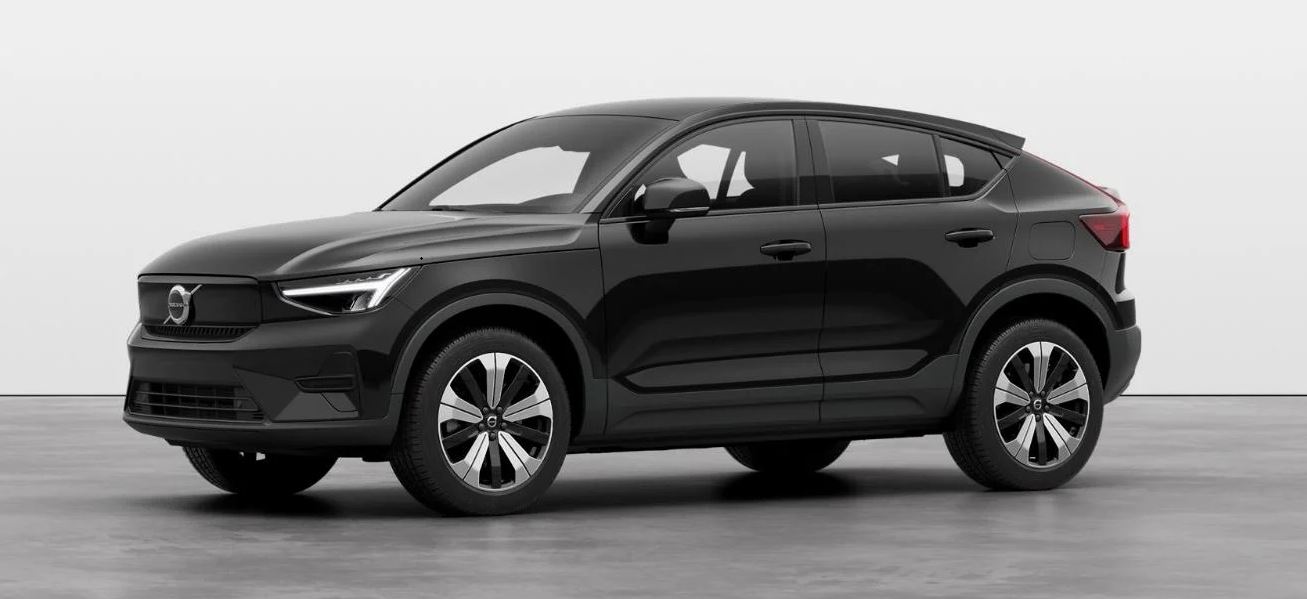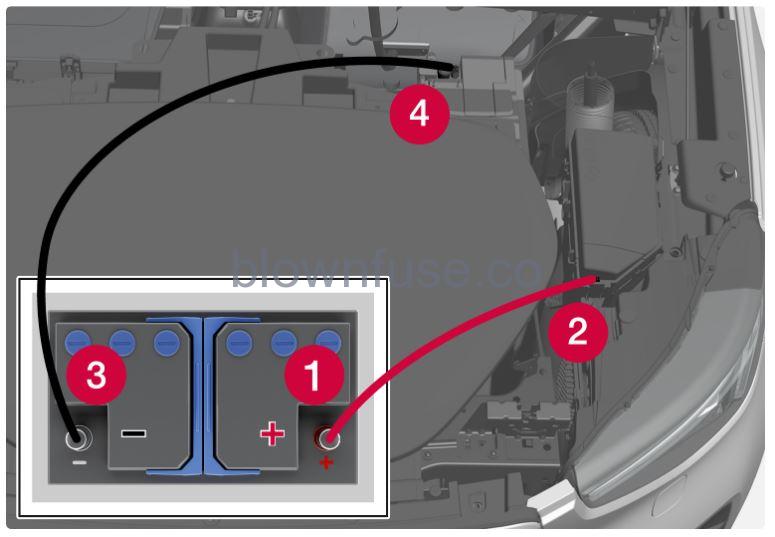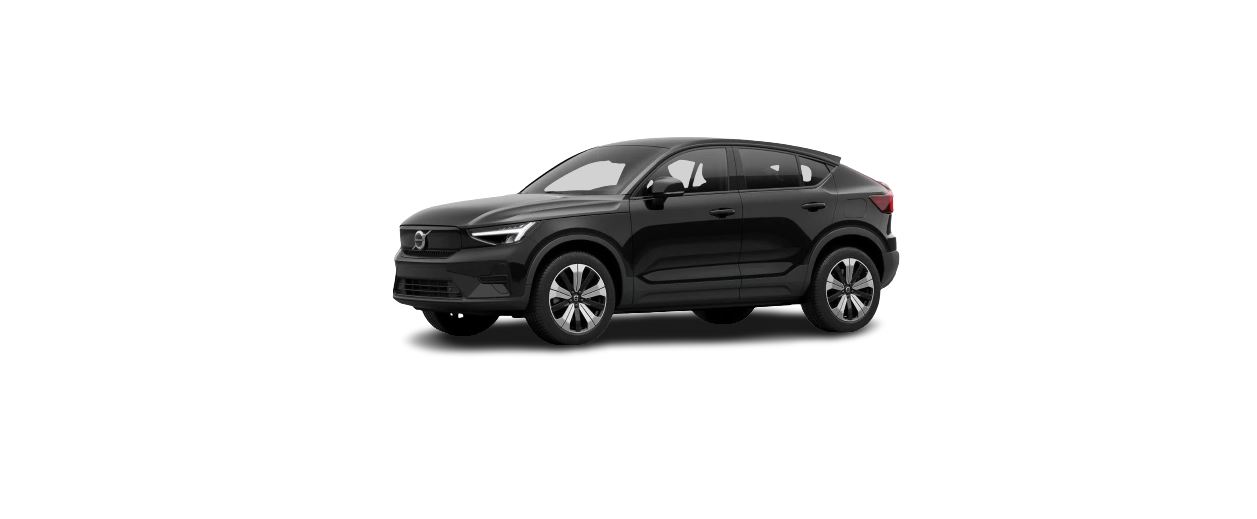2023 Volvo C40 Recharge Starting and switching off the car

Immobilizer
The car can only be started with the correct key.
| Symbol | Message | Specification |
|---|---|---|
 |
The car key is not detected. See Owner’s Manual for more information. | Error reading the key during starting – place the key on the key symbol in the tunnel console’s storage compartment and try again. |
Starting the car
WarningBefore starting:
- Fasten the seatbelt.
- Adjust the seat, steering wheel and mirrors.
- Make sure that the brake pedal can be fully depressed.
- Make sure the key is in the car.
- Put the seatbelt on.
- Depress the brake pedal.
- Change gear to D or R.
- The car is now in Drive mode.
- Release the brake pedal.
- If One Pedal Drive has been activated, the car will not drive forwards, but may roll away if the surface is sloping in the same direction as the selected gear position.
- If One Pedal Drive is deactivated, the car will drive slowly in the selected direction with gentle pressure on the accelerator pedal.
Important
The car cannot be started if the charging cable is still connected. Make sure the charging cable is unplugged and the charging hatch is closed before starting the car.
Using jump starting with another battery
- If the car does not start, it may be due to the 12V battery being discharged. It can be charged using another car’s 12 V battery or an external charger.
- Under normal conditions, the 12V battery is charged at the same time as the car is charged, as well as via current transmission from the high voltage battery when the car is not connected for charging.
- If the 12V battery is discharged for any reason, jump-starting can still be used. This may be caused by the car not being used for a long time, a temporary fault, or a blown fuse in the car’s charging circuit. A discharged 12 V battery needs to be recharged in order to start the car and power its electrical system. After starting, it is possible to start charging the car using the charging cable, which will be necessary if the high voltage battery is also discharged. If the car is out of reach for charging in such a situation, it may need recovery.
- You need jump leads in order to use jump-starting and these are connected to the car’s charging points for the 12 V battery.
- You will need to remove a number of panels under the bonnet in order to access the charging points.
Important
The car’s charging points are only intended for jump-starting the car itself. The charging points are not intended for jump-starting another car. Using the charging points for jump-starting another car may cause a fuse to blow, which means the charging points will stop working. If the message 12 V battery fuse failure Service required is shown in the driver display then a fuse has blown and needs to be changed. Volvo recommends that an authorized Volvo workshop should be contacted.

Several of the panels around the storage area need to be loosened for access to the charging points under the bonnet. When jump-starting the car, the following steps are recommended to avoid short circuits or other damage: Set the car’s electrical system in Passive usage mode. Check that the donor battery has a voltage of 12 V. If the battery is installed in another car – switch off its engine and make sure that the cars do not touch each other. Connect one of the red jump lead clamps to the donor battery’s positive terminal (1).
Important
- Handle the jump leads with care. A short circuit may occur if the ends come into contact with surfaces other than the charging points.
- Open the cover (2) for the positive charging point by pressing on its side. This disengages a hook and you can lift the cover-up at the same time. There are two connection points under the cover. Use it closest to the center of the car.
- Attach the red jump lead’s other clamp onto the car’s positive charging point (2).
- Connect one of the black jump lead’s clamps to the donor battery’s negative terminal (3).
- Attach the black jump lead’s other clamp onto the car’s negative charging point (4).
- Check that the jump lead clamps are affixed securely. Poor contact may cause sparks or the clamps to loosen during the starting attempt.
- Start the engine of the donor car.
- Start the car that has the discharged battery by keeping your foot on the brake and selecting gear position D or R.
Important
Do not touch the connections between cable and car during the starting attempt. There is a risk of sparks forming.
Note
- Full starting is indicated by means of the driver display’s indicator lamps extinguishing and its preset theme illuminating.
- If the high voltage battery is also discharged, start charging the car with the charging cable.
- Remove the jump leads in reverse order – first the black and then the red.
- Make sure that the black jump lead’s clamps do not come into contact with the car’s positive charging point, the donor battery’s positive terminal, or the red jump lead’s clamps.
Note
A discharged 12 V-battery needs to be charged for a while in order to power the car’s electrical system. In an outside temperature of approx. +15 °C (approx. 60 °F), the battery needs to be charged for at least 30 minutes by the car. In a lower outside temperature, the charging time may increase to 3–4 hours. If possible, you should use an external battery charger to charge the battery.
Warning
- The 12 V battery can generate oxyhydrogen gas, which is highly explosive. A spark can be formed if a jump lead is connected incorrectly, and this can be enough for the battery to explode.
- The 12 V battery contains sulphuric acid, which can cause serious burns.
- If sulphuric acid comes into contact with eyes, skin or clothing, flush with large quantities of water. If acid splashes into the eyes – seek medical attention immediately.
- Never smoke near the battery.
Switching off the car
Automatic deactivation
- Activate the parking brake.
- Open the driver’s door.
- The car is now not in Drive mode.
Manual closing via the centre display
If is possible to switch off the car manually.
- Activate the parking brake.
- Press
 .
. - Select Controls.
- Press Power off car.
- Follow the instructions in the screen.
- The car is now not in Drive mode.
Usage modes
The car is set automatically to different modes: passive, comfort and drive. The table shows which functions are available in the various modes.
| Position | Functions |
|---|---|
| Passive | When the car is unlocked, the following functions become available:
In this mode, the functions are controlled by time and are switched off automatically after a short while. |
| Comfort | When someone is sitting in the driver seat or when the centre display is used or started via the media button in the tunnel console:
|
| Drive | When the driver sits in the driver seat and engages a gear:
All functions are available and the car can be driven. |

